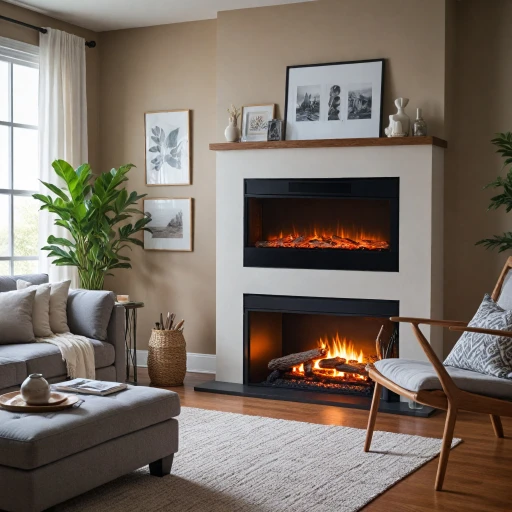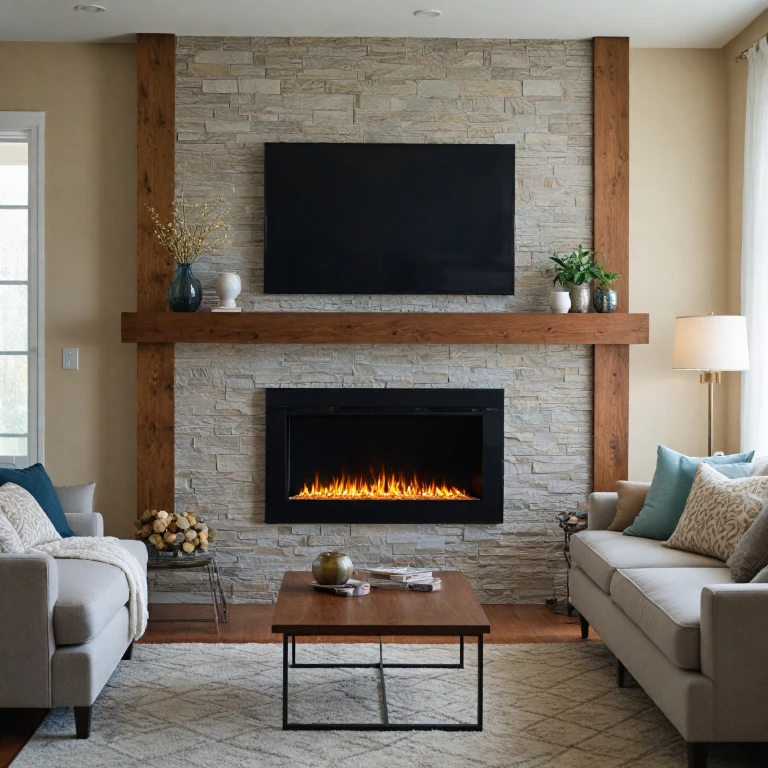Understanding Electrical Codes
Demystifying Electrical Codes for Electric Fireplaces
Electric fireplaces are rapidly becoming a favorite heating option for homeowners across the globe. Whether it’s the cozy ambiance they offer or their efficiency, especially in a small room or bedroom, they’re the perfect alternative to traditional wood burning or gas fireplaces. Let's break down what you need to know—a vital piece of the puzzle is understanding the electrical codes involved in the process. This ensures not only efficient installation but, more importantly, your safety.
The phrase "electrical code" refers to a set of standards that dictate how electrical systems should be installed in any building. It serves as a guide to ensure installations are safe and up to the required national electrical standards. The most commonly referenced is the National Electrical Code (NEC), which is essential across various states in the USA. Knowing these codes can help you ensure proper safety and efficiency when installing an electric fireplace.
Why Codes Matter
Following electrical codes might seem like just a formality, but it's crucial for ensuring your electric fireplace operates safely and efficiently. It helps prevent potential risks like fire hazards and electrical short circuits. Furthermore, it ensures that your fireplace will be compatible with existing circuits, helping you avoid the mistake of overloading outlets or breakers, detailed further in the step-by-step guide.
Voltage and Amperage Essentials
Electric fireplaces typically use 120 volts and require a dedicated circuit for installation. This means they need their own "circuit breaker" and can’t share with other heavy appliances. This makes sure your electric fireplace will receive the adequate power it needs without tripping your house's overall circuit.
Common Pitfalls and Compliance
Even though compliance with the codes might seem cumbersome, it helps avoid common mistakes that many homeowners make, like neglecting the necessity of a dedicated circuit. Not using a dedicated amp circuit might lead your electric fireplace to cause circuit overloads, resulting in frequent breaker trips.
With the groundwork of electrical codes laid out, you're set to tackle the next stages of your electric fireplace install. It’s also important to consider the tools and materials needed, and to understand when you might need professional help. Remember, ensuring the right electrical code compliance will pave the way for a safe, warm, and inviting home atmosphere provided by your electric fireplace.
Essential Tools and Materials for Wiring
Setting up an electric fireplace in your home is about more than just adding warmth and ambiance. It's important to have the right equipment for a smooth installation process that ensures both function and safety. Before tackling your electric fireplace project, gather these key tools and materials.
- Multimeter: This handy gadget is crucial for checking voltage, ensuring that your electric circuits are safe and ready.
- Screwdriver Set: You'll need these for fastening outlet covers, mounting brackets, and adjusting other components.
- Wire Strippers: Necessary for stripping the insulation from wires without damaging them.
- Electrical Tape: Provides a safe way to wrap wires and prevent potential electrical hazards.
- Junction Box: Used for housing electrical connections to hide and protect wires from damage.
- Wire Nuts: Essential for connecting two or more electrical wires together.
- Voltage Tester: It helps verify that circuits are not live before beginning your installation.
- Pipe Cutter (if needed): Cut conduits to size for neat and tidy installations.
Make sure your circuit can support your chosen fireplace model. Most electric fireplaces require a dedicated 15 or 20-amp circuit to operate safely without triggering the breaker. Some units even specify a dedicated circuit with 120 volts, so check the manufacturer's recommendations.
For installations near water sources, like in a bathroom or a fireplace bedroom, it may be beneficial to use Ground Fault Circuit Interrupter (GFCI) protection. GFCI outlets can prevent electrical shock hazards in case of accidental water contact.
Keep in mind that the electrical requirements will differ if you're converting from a wood burning or gas fireplace to an electrical one. Consider these aspects in tandem with safety tips from electricians because peace of mind is just as warm and comforting as those modern flames.
By equipping yourself with these tools and understanding the materials necessary, you'll be well-prepared for the set-up, avoiding many of the common missteps in the process. Also, always remember that during installation, if there's any uncertainty, calling a professional can save time and ensure everything is up to code.
Step-by-Step Wiring Guide
Step-by-Step Installation Guide
Starting with the process of wiring your electric fireplace may seem a tad intimidating, but breaking it down into simple steps tends to make it more approachable. Before you begin, you should've already familiarized yourself with electrical requirements and ensured you've got the necessary tools ready. Let's get into the action:
- Assess Electrical Compatibility: Ensure that your room's voltage and amperage are in sync with your electric fireplace's specifications. Most modern fireplaces require a dedicated circuit to function optimally and safely.
- Plan Your Installation Location: Decide where on your wall you want to install the electric fireplace. It should be near an electrical outlet to avoid stretching power cables awkwardly across your room.
- Install the Outlet: If you haven’t already, install a dedicated outlet in the wall where your fireplace will be mounted. The recommended setup involves a 15 to 20-amp circuit breaker.
- Connect the Wiring: Safely connect the wires from your fireplace to the dedicated circuit outlet. Make sure the connections are secure and that no wires are exposed, adhering closely to national electrical codes.
- Secure and Mount the Fireplace: With the wiring completed, mount your electric fireplace based on the manufacturer’s instructions. Ensure it’s securely fastened to prevent accidents or shifts.
- Test the Setup: Once connected, switch on your circuit breaker and test the fireplace. Look for smooth flame effects and adequate heat output, ensuring everything operates without tripping the breaker.
By following these practical steps, your electric fireplace should be ready to warm your room comfortably. Always double-check connections and safety measures, because prioritizing safety can never go wrong.
Common Mistakes to Avoid
Avoiding Common Pitfalls
When it comes to setting up your electric fireplace, the last thing you want is to stumble upon issues that could have been easily avoided. Let's go over some frequent mistakes people make during the install process—and how to steer clear.
- Overloading Shared Circuits: One of the most common mishaps is plugging the fireplace into a shared circuit instead of a dedicated circuit. Remember, fireplaces require a lot of power, often more than a typical outlet can safely handle if other appliances are running on the same line.
- Incorrect Breaker Size: Make sure your circuit breaker matches the electrical requirements of your fireplace. Using an improper breaker can lead to tripped circuits or, worse, potential safety hazards. Check that the breaker’s amperage supports the heater’s wattage needs.
- Ignoring Outlet Placements: Placing an electric fireplace near an improper outlet can be a fire hazard. The electrical code specifies safety measures regarding outlet placements and power source locations. If you're setting up your fireplace in a bedroom or on a wall, verify that the outlet is appropriate and safe for installation.
- Neglecting GFCI Protection: Especially if your fireplace is installed in areas potentially exposed to water, like near a bathroom or kitchen, make sure the outlet has GFCI protection to prevent electrical shocks.
Mistakes like these can detract from the warm and inviting ambiance you seek from electric fireplaces. For more details on troubleshooting common issues, head over to Electric Fireplace Guru’s
blog post on solving common issues with your electric fireplace. By following the guidelines from the electrical codes and checking with professionals when needed, your installation will be as smooth and stress-free as snuggling up in front of your modern flames with a good book or favorite series.
Safety Tips and Best Practices
Smart Safety Practices for Electric Fireplace Installations
Getting the wiring right for your electric fireplace isn't just about following the national electrical code, it's about keeping you and your loved ones safe and snug by that inviting modern flame in your room. Here’s how you can be sure your electric fireplace is secure and cozy all at the same time.
- Dedicated Circuits are a Lifesaver: To prevent overloading, ensure that your electric fireplace has its own dedicated circuit. This not only fulfills electrical requirements but also backed by the wisdom of the national electrical standards and keeps your breaker from tripping every time you run the vacuum.
- Amp Circuit Checks: Knowing the wattage amperage of your fireplace and ensuring the amp circuit can handle it is key. Too much juice? You might need to get a higher-rated circuit installed. Better safe than sorry, right?
- Keep an Eye on the Heat: Heat output is great for warm fuzzies but keep flammable items at a safe distance from your fireplace. While it’s less risky than traditional wood burning, safety first!
- GFCI Protection is the Way to Go: If installing in a bathroom or outdoor area, it's wise to protect against shocks with GFCI outlets. Your electric safety game will be top-notch while maintaining elegance.
- Stay a Step Ahead of Common Mistakes: Previously mentioned wiring missteps can lead to hazards, so avoid shared circuits to keep things running smoothly and safely.
- A Lookout for Outlets: Ensure any outlets near your electric fireplace are compliant with electrical safety codes. Using a standard wall outlet might seem okay, but checking for voltage compatibility is a must.
- Professionals are Your Friends: When things get beyond your skill level, don’t hesitate to ring up a professional. An expert hand can assure you that “I’ll just do it myself” doesn’t lead to “I wish I hadn’t.”
Remember, a comfortable room with the perfect temperature and ambience needs nothing less than utmost attention to safety. Keep these simple tips in mind for an electric fireplace experience that lets you rest easy and stay cozy.
When to Call a Professional
Recognizing When Professional Assistance is Necessary
Installing an electric fireplace might seem straightforward with the right tools and a clear step-by-step guide. However, there are situations where it's critical to reach out to a professional. Here's when you should consider calling in an expert.
- Complex Electrical Changes: If your fireplace installation requires modifications to the existing electrical circuit or installation of a new dedicated circuit, a licensed electrician is your best bet. They'll ensure that all electrical requirements, from wiring to volts and amps, are safely met according to national electrical codes.
- GFCI and Safety Concerns: Incorporating GFCI protection is crucial for installations near water sources or in specific areas of the home like the bathroom or certain sections of the room where the risk of dampness or spills is higher. A professional can ensure these requirements are properly implemented, offering peace of mind concerning the safety of your fireplace.
- Circuit Overloads and Capacity: If you're unsure about the capacity of your circuit or breaker, especially when adding a new appliance such as a built-in electric fireplace, a professional can assess whether your system can handle the additional load without causing overloads that could result in tripped breakers or, worse, electrical fires.
- Wall-Mounted Installations: When installing wall-mounted fireplaces, precise measurements and structural considerations are crucial to guarantee both safety and aesthetic appeal. Professionals possess the experience to assure that the installation supports the fireplace's heat output without compromising the structure.
- Troubleshooting Installation Issues: Sometimes, despite careful efforts, issues can arise, such as incorrect wiring or unexpected heat output problems. Professionals can swiftly identify and rectify complex problems, ensuring your electric fireplace functions efficiently.
Don't hesitate to reach out to a trusted professional if these situations arise. Their expertise not only assures proper and safe installation but also enhances the longevity and performance of your electric fireplace.

